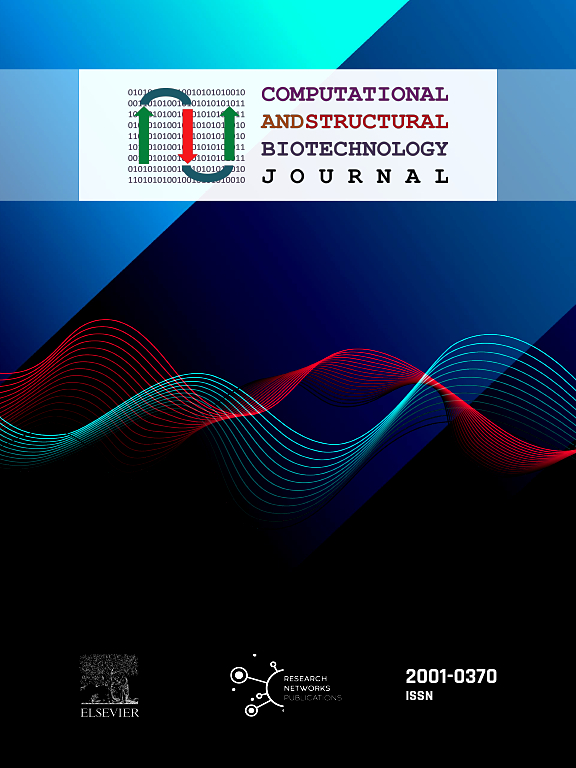肺动脉高压目标算法提高转诊到右心导管:一种机器学习方法
IF 4.4
2区 生物学
Q2 BIOCHEMISTRY & MOLECULAR BIOLOGY
Computational and structural biotechnology journal
Pub Date : 2024-12-01
DOI:10.1016/j.csbj.2024.11.031
引用次数: 0
摘要
肺动脉高压(PH)是一种病理生理问题,可能涉及多种临床症状,并与各种呼吸系统和心血管疾病有关。它的诊断是有创的右心导管(RHC),这是很难执行常规。本研究的目的是开发一种基于记忆数据分析的机器学习(ML)算法,以预测有创测量PH的存在。方法在2017年10月至2020年10月期间纳入226例疑似PH的RHC临床指征患者。根据推荐的指南,所有患者都接受了PH诊断技术方案。机器学习(ML)方法被认为是开发分类器,旨在根据患者的特征、记忆数据、非侵入性参数、经胸超声心动图(TTE)结果和肺活量测定结果,自动检测受PH影响的患者。结果在收集到的51个RHC患者的变量中,有12个在RHC阳性和阴性患者之间有显著性差异。从中选取8个样本进行训练和验证弹性网络正则化广义线性模型(Elastic-Net regularization Generalized Linear Model),并据此建立风险评分。识别模型的AUC为83%,总体准确率为74% [95% CI(61%, 84%)],表明对有和没有病理的患者有很好的区分。结论以PH为目标的ML模型可以简化常规的PH筛查,促进早期发现和更好的RHC转诊。本文章由计算机程序翻译,如有差异,请以英文原文为准。
A pulmonary hypertension targeted algorithm to improve referral to right heart catheterization: A machine learning approach
Background
Pulmonary hypertension (PH) is a pathophysiological problem that may involve several clinical symptoms and be linked to various respiratory and cardiovascular illnesses. Its diagnosis is made invasively by Right Cardiac Catheterization (RHC), which is difficult to perform routinely. Aim of the current study was to develop a Machine Learning (ML) algorithm based on the analysis of anamnestic data to predict the presence of an invasively measured PH.
Methods
226 patients with clinical indication of RHC for suspected PH were enrolled between October 2017 and October 2020. All patients underwent a protocol of diagnostic techniques for PH according to the recommended guidelines. Machine learning (ML) approaches were considered to develop classifiers aiming to automatically detect patients affected by PH, based on the patient’s characteristics, anamnestic data, and non-invasive parameters, transthoracic echocardiography (TTE) results and spirometry outcomes.
Results
Out of 51 variables of patients undergoing RHC collected, 12 resulted significantly different between patients who resulted positive and those who resulted negative at RHC. Among them 8 were selected and utilized to both train and validate an Elastic-Net Regularized Generalized Linear Model, from which a risk score was developed. The AUC of the identification model is of 83 % with an overall accuracy of 74 % [95 % CI (61 %, 84 %)], indicating very good discrimination between patients with and without the pathology.
Conclusions
The PH-targeted ML models could streamline routine screening for PH, facilitating earlier identification and better RHC referrals.
求助全文
通过发布文献求助,成功后即可免费获取论文全文。
去求助
来源期刊

Computational and structural biotechnology journal
Biochemistry, Genetics and Molecular Biology-Biophysics
CiteScore
9.30
自引率
3.30%
发文量
540
审稿时长
6 weeks
期刊介绍:
Computational and Structural Biotechnology Journal (CSBJ) is an online gold open access journal publishing research articles and reviews after full peer review. All articles are published, without barriers to access, immediately upon acceptance. The journal places a strong emphasis on functional and mechanistic understanding of how molecular components in a biological process work together through the application of computational methods. Structural data may provide such insights, but they are not a pre-requisite for publication in the journal. Specific areas of interest include, but are not limited to:
Structure and function of proteins, nucleic acids and other macromolecules
Structure and function of multi-component complexes
Protein folding, processing and degradation
Enzymology
Computational and structural studies of plant systems
Microbial Informatics
Genomics
Proteomics
Metabolomics
Algorithms and Hypothesis in Bioinformatics
Mathematical and Theoretical Biology
Computational Chemistry and Drug Discovery
Microscopy and Molecular Imaging
Nanotechnology
Systems and Synthetic Biology
 求助内容:
求助内容: 应助结果提醒方式:
应助结果提醒方式:


